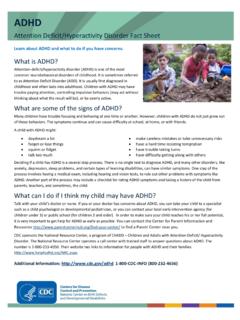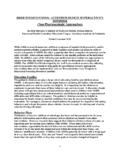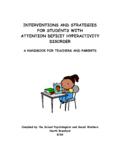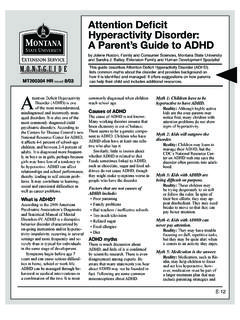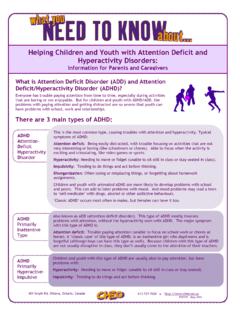Transcription of Classroom Seating for Children With Attention Deficit ...
1 40 Classroom Seating for Children With Attention Deficit hyperactivity Disorder: Therapy Balls Versus Chairs KEY WORDS environment participation school-based therapy Denise Lynn Schilling, Kathleen Washington, Felix F. Billingsley, Jean Deitz OBJECTIVE. The purpose of this study was to investigate the effects of therapy balls as Seating on in-seat behavior and legible word productivity of students with Attention Deficit hyperactivity disorder (ADHD). Additionally, social validity was assessed to evaluate teacher and student opinions regarding the intervention. METHOD. A single subject, A-B-A-B interrupted time series design was employed across 3 students (2 males, 1 female) with ADHD.
2 The study was conducted in a 4th grade inclusive Classroom during daily language arts. During phases 1 and 3, the 3 participants and all other class members sat on chairs (in-seat on chair); during phases 2 and 4, everyone sat on therapy balls (in-seat on ball). Dependent variables were in-seat behavior and legible word productivity. Data were graphed and visually analyzed for differences between phases. RESULTS. Results demonstrated increases in in-seat behavior and legible word productivity for the students with ADHD when seated on therapy balls. Social validity findings indicated that generally the teacher and students preferred therapy balls. CONCLUSION. This study provides evidence that use of therapy balls for students with ADHD may facilitate in-seat behavior and legible word productivity. Schilling, O. L., Washington, K., Billingsley, , & Deitz, J. (2003). Classroom Seating for Children with Attention Deficit hyperactivity disorder: Therapy balls versus chairs.
3 American Journal of Occupational Therapy, 57, 534-541. Reprinted from The American Journal of Occupational Therapy (Volume 57, Number 5) with permission from The American Occupational Therapy Association, Inc. (AOTA). Copyrighted 2003 by AOTA, 4720 Montgomery Lane, Bethesda, MD 20824. All rights reserved on products published by AOTA, please call 301-652-2682 or visit Denise Lynn Schilling, MS, PT, was a graduate student at the time of this study in the Masters of Science Program, Department of Rehabilitation Medicine, University of Washington, Seattle, Washington. Mailing address: 4210 258th Avenue SE, Issaquah, Washington 98029. Kathleen Washington, PhD, PT, is Clinical Assistant Professor, Department of Rehabilitation Medicine, University of Washington, Seattle, Washington. Felix E Billingsley, PhD, is Professor and Chair, Special Education, University of Washington, Seattle, Washington. Jean Deilz, PhD, OTR/L, FAOTA, is Professor and Graduate Program Coordinator, Department of Rehabilitation Medicine, University of Washington, Seattle, Washington.
4 Attention Deficit hyperactive disorder (ADHD) is the most frequently diagnosed neurobehavioral disorder in childhood (Kauffman, 2001). Current estimates indicate the prevalence of ADHD in the United States ranges from approximately 4% to 6% of school-age Children (Jaksa, 1998; Rosenblum, 2000) to as high as 13% in America's inner cities (Goldman, Genel, Bezman, & Slanetz, 1998; Meaux, 2000). According to Mulligan (2001), Children diagnosed with ADHD often experience significant academic and sensory motor problems that make typical school activities a challenge. Goldstein and Goldstein (1992) identified sitting and paying Attention as problems for these Children in the Classroom , and Barkley (1990) noted that Children with ADHD often fail to complete assignments or underperform academically. As a result of the increasing numbers of Children with ADHD and the identified problems, Mulligan (2001) made two recommendations.
5 First, she maintained that there is an increased need for therapists to be knowledgeable about ways of managing the Classroom behaviors of Children with ADHD; second, she identified the need for strategies designed to enhance the school performance of these Children . These recommendations seem especially important since many Children with ADHD experience a wide range of secondary behavioral and emo-tional problems at school (Goldstein & Goldstein, 1992), and more than one third of students with ADHD drop out of school (Rosenblum, 2000). 41 Mulligan (2001) suggested that sensory modulation deficits might be a factor in Children who demonstrate Attention deficits.
6 According to Miller and Lane (2000), sensory modulation "reflects an adjustment in ongoing physiological processes to ensure internal adaptation to new or changing sensory information". ( ) Furthermore, Hanft, Miller, and Lane (2000) noted that since interactions between tasks, environments, and people continually change, a person's responses may fluctuate considerably, not only day to day, but within an activity. Therefore, it seems that one potential intervention approach to address the behavioral problems of Children with ADHD at school is to adapt the environment to meet the Children 's needs. Occupational therapy literarure has specifically suggest-ed the implementation of sensory modulation strategies in classrooms for the purpose of improving the Classroom performance of Children with ADHD (Kimball, 1999; Mulligan, 1996). One possible strategy of using therapy balls for Seating was suggested by back-health studies.
7 Incidental to these studies, researchers commented that Children using therapy balls in the Classroom appeared to improve in Attention , sustained sitting, and school performance (Illi, 1994; Witt & Talbot, 1998). These behaviors are compatible with Ayres' suggestion that an overexcited child may be calmed by gently rocking on a ball (Ayres, 1977). Though these reports and the literature, either directly or indirectly, suggested the use of therapy balls for Classroom Seating for Children with ADHD, prior to the current study, no studies had systematically examined the use of this strategy for such Children . Therefore, the purpose of this study was to examine the use of therapy balls for Classroom Seating as an intervention for Children with ADHD. Two specific research questions were addressed. First, what effect does using therapy balls as chairs have on in-seat behavior?
8 Second, what effect does sitting on balls have on legible word productivity? In addition, social validity was examined to evaluate the teacher's and students' opinions regarding the acceptability and viability of the intervention. Schwartz and Baer (1991) recommended that social validity assessment be a standard part of applied behavioral research since it is possible for an intervention to result in positive changes in dependent variables while simultaneously being identified by research participants as unacceptable. Method This study used a single subject, A-B-A-B interrupted time series design (Kazdin, 1982) across three students with ADHD. During baseline phases (A), participants and all other members of the class used chairs during language arts; during intervention phases (B), participants and all other members of the class sat on therapy balls during language arts.
9 The language arts period was chosen because it occurred at the same time daily (immediately after lunch recess) and it was a time in the Children 's daily schedules when they were regularly involved in producing written assignments. The total study was 12 weeks in length; each phase was 3 weeks long. Participants A convenience sample was used from a 4th-grade Classroom in a public school in the state of Washington. Three Children with a diagnosis of ADHD participated in this study; however, all 24 students in the Classroom used the balls and chairs. Study procedures were approved by a university human subjects review committee and met the requirements of the school district where the study was implemented. The participants, 1 female and 2 males, were ages 9 years, 11 months; 9 years, 11 months; and 9 years, 8 months, respectively. Each had a physician's diagnosis of ADHD.
10 In addition, one male had a concomitant diagnosis of oppositional defiant disorder and the other male a concomitant diagnosis of severe behavior disorder. All were of average intelligence or above as defined by a score equal to 80 or above on the Wechsler Intelligence Scale for Children (Wechsler, 1991). Each participant was taking Clonidine, Ritalin, or Adderall. Medications remained constant throughout the study. Prior to the study, all participants regularly demonstrated out-of-seat behavior during the language arts period and required repeated verbal reminders or physical prompts or both from the teacher. Independent Variable The therapy balls selected for Classroom use had molded feet (Sit 'n' GymTM by Gymnic) that extended when the ball was not in use to prevent rolling away. Therapy balls were individually fitted for each student in the Classroom for a diameter that assured the student could sit comfortably with his or her feet flat on the floor with knees and hips flexed at 90 degrees.


